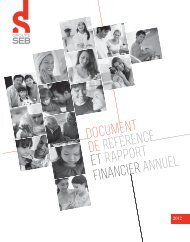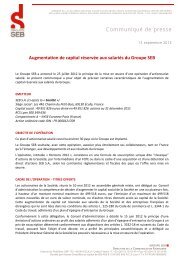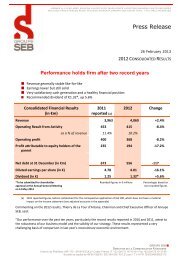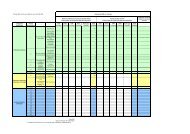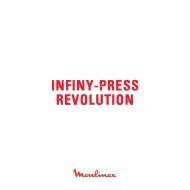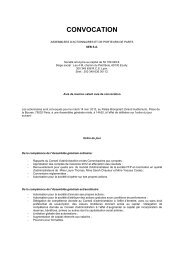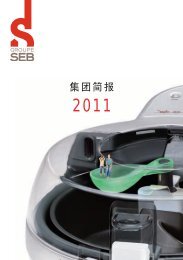Financial Report and Registration Document 2010 - Groupe Seb
Financial Report and Registration Document 2010 - Groupe Seb
Financial Report and Registration Document 2010 - Groupe Seb
You also want an ePaper? Increase the reach of your titles
YUMPU automatically turns print PDFs into web optimized ePapers that Google loves.
3<br />
CONSOLIDATED FINANCIAL STATEMENTS<br />
NOTES TO THE CONSOLIDATED FINANCIAL STATEMENTS<br />
The assumptions used – which mainly concern impairment tests on<br />
non-current assets – <strong>and</strong> the sensitivity of reported amounts to changes in<br />
these assumptions are presented in the relevant notes to these consolidated<br />
financial statements, in accordance with IAS 36.<br />
Estimates are adjusted following any change in the circumstances on which<br />
they were based or when any new information comes to light. Actual results<br />
may differ from these estimates <strong>and</strong> assumptions.<br />
The main estimates <strong>and</strong> assumptions used to prepare the consolidated<br />
financial statements concern the measurement of pension <strong>and</strong> other<br />
post-employment benefit obligations (Note 22.1), deferred taxes (Note 1.4.9),<br />
property, plant <strong>and</strong> equipment (Note 1.4.3), intangible assets (Notes 1.4.1 <strong>and</strong><br />
10), investments in associates <strong>and</strong> other investments, impairment of current<br />
assets (Notes 1.4.5 <strong>and</strong> 1.4.6), short <strong>and</strong> long-term provisions (Notes 1.4.10<br />
<strong>and</strong> 1.4.11), certain financial instruments (Note 1.4.4 – Derivative instruments)<br />
<strong>and</strong> share-based payments (Note 1.4.10).<br />
1.4. ACCOUNTING POLICIES AND VALUATION<br />
METHODS<br />
The financial statements of Group companies are prepared in accordance<br />
with local generally accepted accounting principles. They are restated where<br />
necessary to comply with Group accounting policies.<br />
The notes to the consolidated financial statements include analyses of assets<br />
<strong>and</strong> liabilities by maturity where disclosure of this information is required<br />
under IFRS.<br />
The methods used to measure intangible assets, property, plant <strong>and</strong><br />
equipment, inventories <strong>and</strong> trade receivables are described below.<br />
1.4.1. Intangible assets<br />
A) DEVELOPMENT COSTS<br />
Under IAS 38 – Intangible Assets, research costs are recognised as an<br />
expense <strong>and</strong> development costs are recognised as an intangible asset when<br />
the Group can demonstrate (IAS 38, paragraph 57):<br />
its intention to complete the development project;<br />
that it is probable that the expected future economic benefits attributable<br />
to the asset will flow to the Group;<br />
its ability to measure reliably the cost of the asset.<br />
Development costs that do not fulfi l the above criteria are expensed as<br />
incurred.<br />
In the consolidated fi nancial statements, qualifying development costs<br />
incurred after the advance design phase <strong>and</strong> before the manufacturing phase<br />
are recognised as intangible assets.<br />
Development costs are amortised on a straight-line basis over three to<br />
five years, corresponding to the same useful life as that applied to specific<br />
tooling.<br />
B) OTHER INTANGIBLE ASSETS<br />
Software licences <strong>and</strong> internal software development costs are recognised as<br />
intangible assets when it is probable that they will generate future economic<br />
benefits. They are amortised by the straight-line method over periods ranging<br />
from three to five years. Other software licences <strong>and</strong> software development<br />
costs are expensed as incurred.<br />
Patents, licences <strong>and</strong> trademarks with a finite useful life are amortised over<br />
the shorter of the period of legal protection <strong>and</strong> their expected useful life,<br />
not to exceed fifteen years.<br />
Trademarks with an indefinite useful life are not amortised but are tested<br />
for impairment.<br />
C) GOODWILL<br />
Goodwill, corresponding to the excess of the Group’s interest in net fair value<br />
of the identifiable assets <strong>and</strong> liabilities acquired in a business combination<br />
over the consideration transferred, is recognised in the balance sheet as<br />
an asset under “goodwill”. The consideration transferred is measured as<br />
the fair value of assets transferred, equity instruments issued <strong>and</strong> liabilities<br />
incurred by the acquirer to the former owner on the acquisition date, plus any<br />
contingent consideration. In the case of a business combination achieved in<br />
stages, the difference between the carrying amount of the previously held<br />
interest <strong>and</strong> its acquisition-date fair value is recognised directly in profit or<br />
loss on the acquisition date.<br />
For each business combination, any non-controlling interest in the acquiree<br />
may be measured either at fair value on the acquisition date (full goodwill<br />
method) or at the non-controlling interest’s proportionate share of the<br />
acquiree’s identifiable net assets (partial goodwill method).<br />
The fair values provisionally attributed to identifiable assets <strong>and</strong> liabilities,<br />
non-controlling interests measured at fair value <strong>and</strong> the various components<br />
of the consideration transferred may be adjusted for a period of twelve<br />
months after the acquisition date. After that period, any adjustments are<br />
recognised prospectively in profit or loss with no adjustment to goodwill.<br />
Goodwill is not amortised but is tested for impairment at least once a year.<br />
For impairment testing purposes, goodwill is allocated to a Cash-Generating<br />
Unit (CGU), defined as the smallest identifiable group of assets that generates<br />
cash infl ows that are largely independent of the cash infl ows from other<br />
assets or groups of assets<br />
The method used to test CGUs for impairment is described in Note 1.4.3.<br />
When a CGU is found to be impaired, an impairment loss corresponding<br />
to the difference between the carrying amount of the goodwill <strong>and</strong> its<br />
recoverable amount is recognised in “Other operating expense”. Impairment<br />
losses on goodwill are not reversible.<br />
Negative goodwill is recognised directly in the income statement for the<br />
period of acquisition <strong>and</strong> attributed in full to the acquirer.<br />
1.4.2. Property, plant <strong>and</strong> equipment<br />
Property, plant <strong>and</strong> equipment are initially recognised at cost <strong>and</strong> are<br />
depreciated by the straight-line method over their estimated useful lives.<br />
Maintenance <strong>and</strong> repair costs are expensed as incurred.<br />
The main useful lives are as follows:<br />
buildings:<br />
10 to 40 years;<br />
plant <strong>and</strong> machinery:<br />
10 years;<br />
office equipment:<br />
3 to 10 years;<br />
vehicles:<br />
4 to 5 years;<br />
tooling:<br />
1 to 5 years.<br />
Each significant part of an item of property, plant <strong>and</strong> equipment with a useful<br />
life that is different from that of the asset to which it belongs is depreciated<br />
separately. Useful lives are reviewed at regular intervals <strong>and</strong> the effect of<br />
any adjustments – corresponding to a change in accounting estimates – is<br />
applied prospectively.<br />
3<br />
GROUPE SEB<br />
FINANCIAL REPORT AND REGISTRATION DOCUMENT <strong>2010</strong><br />
69



